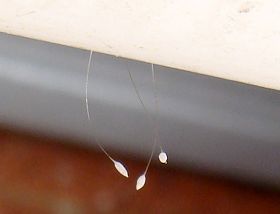(Clearwisdom.net) It was an early August day in 2007. As Ms. Ye, a Falun Gong practitioner in Sidney, was drying her clothes by hanging them on a bamboo stick she found three flowers growing on the bamboo, similar to Udumbara described in Buddhist sutras. They had very slim stems with tiny white stamens on top. Ms. Ye took out her camera and focused the lens on the flowers. She was thrilled to see a light glow over the stems.
Ms. Ye compared the photos of these flowers with those of Udumbara and read related reports. She decided that these three tiny white flowers were indeed Udumbara--flowers that blossom once every three thousand years as described in Buddhist sutras. Ms. Ye's husband is not a Falun Gong practitioner, but he had seen the report about Udumbara on the New Tang Dynasty TV program, Zooming In. He said that these flowers found at his home were exactly the same as those shown on television, and that it must have been an auspicious sign that Falun Gong brought to his family.
According to media reports, since ten Udumbara flowers were first found blossoming on the face of a Bodhisattva statue in the Sumi Zen Temple in South Korea in early May 2005, more have been sighted in the past two years in various places in South Korea, Brisbane, Australia, a few cities in China, Hong Kong, Taiwan and the Americas. But this was the first time that the legendary flowers were found in Sidney.
According to Buddhist sutras, "Udumbara" is a Sanskrit word, meaning "an auspicious flower from heaven." Volume 8 of the Huilin Phonetics and Interpretation, a Buddhist scripture, says: "Udumbara is the product of ominous and supernatural phenomena; it is a celestial flower and does not exist in the mundane world. If a Tathagata or King of the Golden Wheel appears in the human world, this flower will manifest due to their great virtue and blessings."






